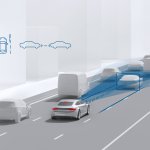
Magna, one of North America’s leading automotive suppliers, partners with Lyft for autonomous vehicle solutions | Source: Pexels
New Magna, Lyft partnership to build self-driving systems at scale
AUTONOMOUS VEHICLES might soon be the taxi service of choice, and a new alliance between Magna and Lyft promises to make that a reality.
A press release announced the multi-year collaboration in which the companies will jointly fund, develop, and manufacture self-driving systems.
In addition, Magna will invest US$200 million in Lyft equity.
#PressRelease – Magna and @lyft Announce a Multi-Year Partnership to Develop and Manufacture Self-Driving Systems at Scale https://t.co/KHMpdCEXXu pic.twitter.com/9JX3V7McDM
— Magna International (@MagnaInt) March 14, 2018
The deal will position Magna and Lyft to develop and manufacture self-driving systems at scale.
According to the terms revealed, self-driving vehicles created by the duo will be deployed on Lyft’s own ridesharing network in the coming years.
However, Magna will also be able to deploy the technology across a wide range of use cases to benefit the entire global mobility ecosystem.
“There is a new mobility landscape emerging and partnerships like this put us at the forefront of this change. Lyft’s leadership in ridesharing and Magna’s automotive expertise makes this strategic partnership ideal to effect a positive change as a new transportation ecosystem unfolds,” said Swamy Kotagiri, Magna Chief Technology Officer.
Here are some of the highlights of the new partnership:
- Lyft will lead the co-development of the self-driving system at its Palo Alto-based self-driving engineering center
- Magna will lead manufacturing and join Lyft’s development team onsite, contributing their vehicle systems knowledge, safety & ADAS expertise, and manufacturing capabilities
- Lyft and Magna will share jointly created IP and utilize Lyft data to improve systems
- Lyft will utilize Magna’s vast automotive experience for its fleet’s self-driving systems
- This scalable technology is expected to be market-ready over the next few years and can be deployed across the industry through Magna
Earlier this year, Magna has unveiled a high definition ICON RADAR that scans the environment in four dimensions. Its press release stated that “ICON RADAR helps close the gap between level 3 and level 5 to reach full reliable autonomous driving.”
Wondering about the difference between level 3 and level 5? Well, according to the society of automotive engineers (SAE), a level 3 vehicle offers conditional automation while a level 5 vehicle offers full automation – the holy grail of driverless cars!
The ICON RADAR in action | Source: Newsroom/Magna
Magna’s ICON RADAR continuously scans its full environment 50 times faster than the time it takes a human to blink an eye, which helps a vehicle make instantaneous decisions in response to complex surroundings.
It can also detect vehicles at distances that well exceed any current requirements. Its state-of-the-art imaging capability pulls from 192 virtual receivers incorporated into a single compact system.
The technology is also naturally immune to interference, which will become critical as the number of radar-enhanced vehicles on the road increases.
Through the partnership with Lyft, Magna is expected to be able to speed up its race to build self-driving systems, quickly.
READ MORE
- Ethical AI: The renewed importance of safeguarding data and customer privacy in Generative AI applications
- How Japan balances AI-driven opportunities with cybersecurity needs
- Deploying SASE: Benchmarking your approach
- Insurance everywhere all at once: the digital transformation of the APAC insurance industry
- Google parent Alphabet eyes HubSpot: A potential acquisition shaping the future of CRM




